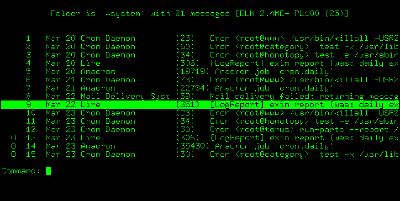I’ve been asked about the reason for
my low opinion of Microsoft. It isn’t just me of course — a lot of technologists regard Microsoft that way. Here’s an anecdote that illustrates why.
The year is 1993. No one’s ever heard of the World Wide Web. Few people have even heard of e-mail. Too often, when I explain my role at the e-mail software startup Z-Code to friends and relatives, I also have to explain what e-mail is in the first place.
Those who do know about e-mail in 1993, if transported to 2009, would not recognize what we call e-mail now. To them, e-mail looks like this:

It’s all plain, unadorned text rendered blockily on monochrome character terminals. For the most part, variable-width, anti-aliased fonts are years in the future. Boldface and italic text exist only in the imagination of the reader of a message that uses ad hoc markup like *this* and _this_. Forget about embedded graphics and advanced layout.
However, in 1993 something has just been invented that will catapult e-mail into the future: the MIME standard, which permits multimedia attachments, rich text markup, and plenty more. Almost no one has MIME-aware e-mail software yet. Meanwhile, at Z-Code, we’re busy adding MIME capabilities to our product, Z-Mail. The capabilities are primitive: for instance, if we detect that a message includes an image attachment, we’ll launch a separate image-viewing program so you can see the image. (Actually rendering the image inline comes much later for everyone.)
The Z-Mail user is able to choose an auto-display option for certain attachment types. If you have this option selected and receive a message with an image attachment, your image-viewing program pops up, displaying the attachment, as soon as you open the message. (Without the auto-display option set, you explicitly choose whether or not to launch the viewer each time you encounter an image attachment.)
There comes the time that the marketing guy at Z-Code asks if we can add automatic launching of Postscript attachments, too. In 1993, Postscript is the dominant format for exchanging printable documents. (Today it’s PDF.) Turns out that a lot of potential Z-Mail users are technically unsavvy business types who exchange Postscript files often, jumping through tedious hoops to attach them, detach them, and print them out. Automatically popping up a window that renders a Postscript attachment right on the screen would be pure magic to them, changing them from potential Z-Mail users into actual Z-Mail users.
But there is a problem. Postscript files differ from image, sound, and other document files in one important respect: whereas those latter types of file contain static, inert data, requiring special programs to render them, Postscript files are themselves full-fledged computer programs. The Postscript renderer is just a language interpreter — like a computer within the computer, running the program described by the Postscript document.
Virtually every Postscript program — that is, document — is completely innocuous: place such-and-such text on the page here, draw some lines there, shade this region, and so on. But it’s perfectly conceivable that a malicious Postscript document — that is, program — can act as a computer virus, or worm, causing the computer to access or alter files, or use the network or CPU in mischievous ways without the user’s knowledge or approval.
So launching the Postscript interpreter with an unknown document is risky at any time. Doing so automatically — as the default setting, no less, which is what the marketing guy wanted — is foolhardy. (The reason it’s generally safe to send Postscript documents to Postscript printers — which include their own Postscript interpreters — is that unlike computers, printers do not have access to resources, like your files, that can be seriously abused.)
We, the Z-Code engineers, explain the situation and the danger. The marketing guy dismisses the possibility of a Postscript-based attack as wildly unlikely. He’s right, but we point out that adding the feature he’s asking for would make such an attack more likely, as word spreads among the bad guys that Z-Mail (a relatively widely deployed e-mail system in its time and therefore a tempting hacking target) is auto-launching Postscript attachments. Marketing Guy argues that the upside of adding the feature is potentially enormous. We say that one spam campaign containing viral Postscript attachments could cripple the computers of Z-Mail users and only Z-Mail users, a potential PR catastrophe. Marketing Guy says that our users don’t know or care about that possibility and neither should we. We say it’s our job to protect our users from their own ignorance.
The issue gets bumped up to Dan, our president, who is clearly leaning toward the marketing guy’s enormous potential upside. But after we vigorously argue the technical drawbacks of the plan and our responsibility to keep our users safe in spite of themselves, he goes with the suggestions from Engineering: do add a Postscript-launching option but turn it off by default, and educate users about the danger when they go to turn it on.
This is a run-of-the-mill example of the kind of tension that exists between Marketing and Engineering in all software companies. Issues like this arose from time to time at Z-Code, and sometimes Engineering carried the day, and sometimes Marketing did. It was a good balance: it took Marketing’s outlandish promises to keep Engineering moving forward, and it took Engineering’s insight and pragmatism to keep the product safe and reliable.
As an industry insider, my impression of Microsoft is that Marketing wins all the arguments, with all that that implies for the safety and reliability of their software.

 Fast forward to several months ago. One Sunday morning my wife woke up wanting to take the kids to see the sea life in tide pools at a local beach. She asked me to determine when low tide would be that day. I googled “bay area” and “tides” — and damn me if
Fast forward to several months ago. One Sunday morning my wife woke up wanting to take the kids to see the sea life in tide pools at a local beach. She asked me to determine when low tide would be that day. I googled “bay area” and “tides” — and damn me if 
 On the spur of the moment, in a tiny casino in Winnemucca, without even realizing I was doing it, I chose. 28 was my number, just as a swinging single lifestyle was my fantasy. But 14 was a number that Andrea and I shared. It’s the day each month that she and I celebrated our
On the spur of the moment, in a tiny casino in Winnemucca, without even realizing I was doing it, I chose. 28 was my number, just as a swinging single lifestyle was my fantasy. But 14 was a number that Andrea and I shared. It’s the day each month that she and I celebrated our